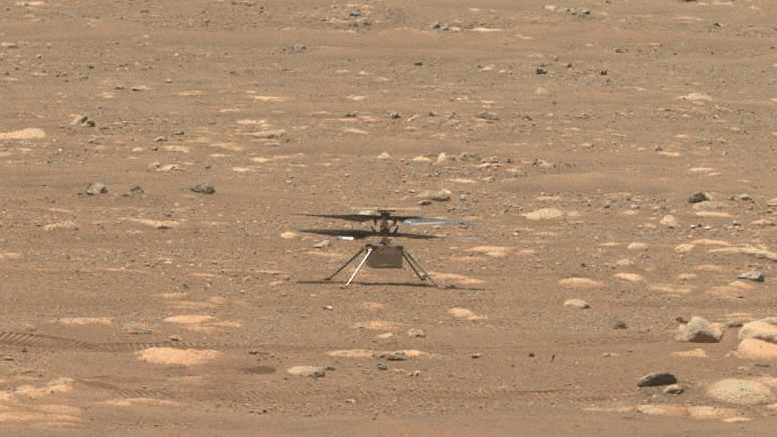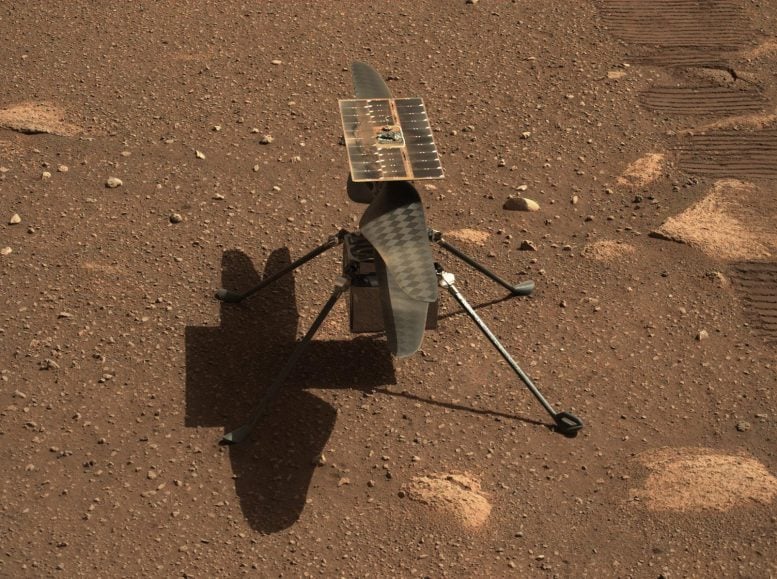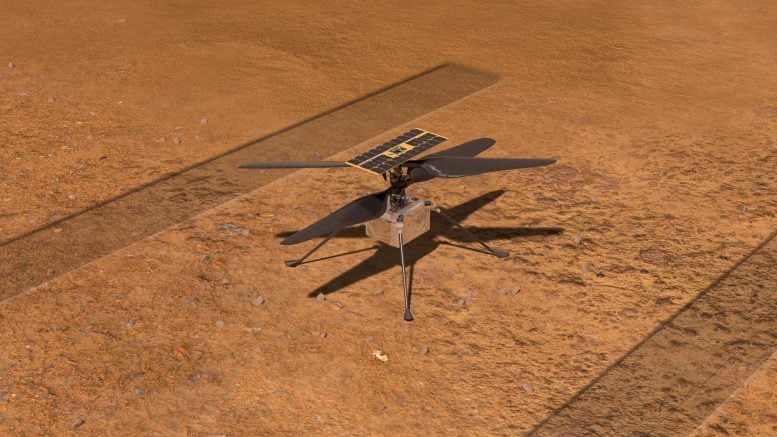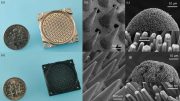The Ingenuity team has identified a software solution for the command sequence issue identified on Sol 49 (April 9) during a planned high-speed spin-up test of the helicopter’s rotors. Over the weekend, the team considered and tested multiple potential solutions to this issue, concluding that minor modification and reinstallation of Ingenuity’s flight control software is the most robust path forward. This software update will modify the process by which the two flight controllers boot up, allowing the hardware and software to safely transition to the flight state. Modifications to the flight software are being independently reviewed and validated today and tomorrow in testbeds at JPL.

NASA’s Ingenuity helicopter does a slow spin test of its blades, on April 8, 2021, the 48th Martian day, or sol, of the mission. This image was captured by the Navigation Cameras on NASA’s Perseverance Mars rover. Credit: NASA/JPL-Caltech
While the development of the new software change is straightforward, the process of validating it and completing its uplink to Ingenuity will take some time. A detailed timeline for rescheduling the high-speed spin-up test and first flight is still in process. The process of updating Ingenuity’s flight control software will follow established processes for validation with careful and deliberate steps to move the new software through the rover to the base station and then to the helicopter. Intermediate milestones include:
- Diagnose the issue and develop potential solutions
- Develop/validate and upload software
- Load flight software onto flight controllers
- Boot Ingenuity on new flight software
Once we have passed these milestones, we will prepare Ingenuity for its first flight, which will take several sols, or Mars days. Our best estimate of a targeted flight date is fluid right now, but we are working toward achieving these milestones and will set a flight date next week. We are confident in the team’s ability to work through this challenge and prepare for Ingenuity’s historic first controlled powered flight on another planet.

NASA’s Ingenuity Mars helicopter is seen here in a close-up taken by Mastcam-Z, a pair of zoomable cameras aboard the Perseverance rover. This image was taken on April 5, the 45th Martian day, or sol, of the mission. Credit: NASA/JPL-Caltech/ASU
Ingenuity continues to be healthy on the surface on Mars. Critical functions such as power, communications, and thermal control are stable. It is not unexpected for a technology demonstration like this to encounter challenges that need to be worked in real time. The high-risk, high-reward approach we have taken to the first powered, controlled flight on another planet allows us to push the performance envelope in ways we could not with a mission designed to last for years such as Perseverance. In the meantime, while the Ingenuity team does its work, Perseverance will continue to do science with its suite of instruments and is gearing up for a test of the MOXIE technology demonstration.










I am not spatiolist in this field, but I guess they are
doing good job to know more about Mars and interplanetary space for humans future.
A software problem is something that could have, and should have, been found and fixed during development. It is not something that is a surprise due to an alien environment.
So glad we have EWK80 here to tell us that NASA software engineers should have figured out everything when there has never been a flight attempted in such an alien and hostile environment.
FYI, a software command sequence error is NOT caused by the alien environment.
There is an elephant in the room: Did they not test this on the ground, before the mission??
For ‘Tired of Idiots’: A software command sequence error is NOT caused by the alien environment.
I’m concerned about what appears to be dust on top of some of the solar cells. Is this a known phenomenon, or will it become a significant problem? Will flight turbulence be able to blow some of it away? Hoping for the best.
The oxygen will wash off the rust when the fan turns off.
What oxygen and what rust?
The atmosphere is mostly CO2, though the high UV radiation generates a lot of oxidants – nor much O2 what I know of.
The solar panels may be silicon or III/V semiconductors for efficiency. In both cases their oxides are mostly transparent and slef-limiting, hence the long term use of solar panels. C.f. how rovers with solar panels and other surfaces don’t rust visibly, but becomes dust covered (and having dust removed by wind gusts) over time.
“What oxygen and what rust?” This is the red planet, not the black planet.
“ Thanks to SAM’s atmospheric analyses, scientists back on Earth were able to determine that the atmosphere’s nitrogen and argon levels followed “a predictable seasonal pattern, waxing and waning in concentration in Gale Crater throughout the year.” Oxygen, though, didn’t follow that pattern at all. Instead, according to NASA, “the amount of the gas in the air rose throughout spring and summer by as much as 30 percent, and then dropped back to levels predicted by known chemistry in fall.” Since the pattern repeated each spring, the researchers suspect that “something was producing it and then taking it away.” But what?
“The first time we saw that, it was just mind boggling,” says Sushil Atreya, a climate scientist at the University of Michigan in Ann Arbor, in a statement. The researchers checked SAM to make sure it was working properly and then tried to brainstorm other possibilities for the fluctuations, but came up with few alternatives.
“We’re struggling to explain this,” says Melissa Trainer, a planetary scientist at NASA’s Goddard Space Flight Center who led this research. “The fact that the oxygen behavior isn’t perfectly repeatable every season makes us think that it’s not an issue that has to do with atmospheric dynamics. It has to be some chemical source and sink that we can’t yet account for.”
“
&&
Atomic oxygen is produced by photolysis of CO2 in the upper atmosphere and can escape the atmosphere via dissociative recombination or ion pickup. In early 2016, Stratospheric Observatory for Infrared Astronomy (SOFIA) detected atomic oxygen in the atmosphere of Mars, which has not been found since the Viking and Mariner mission in the 1970s.[48]
In 2019, Nasa scientists working on the Curiosity rover mission, who have been taking measurements of the gas, discovered that the amount of oxygen in the Martian atmosphere rose by 30% in spring and summer.[49]
Similar to stratospheric ozone in Earth’s atmosphere, the ozone present in the Martian atmosphere can be destroyed by catalytic cycles involving odd hydrogen species:
H + O
3 ⟶ OH + O
2
O + OH ⟶ H + O
2
Net: O + O
3 ⟶ 2O
2
Since water is an important source of these odd hydrogen species, higher abundance of ozone is usually observed in the regions with lower water vapor content.[50] Measurements showed that the total column of ozone can reach 2–30 μm-atm around the poles in winter and spring, where the air is cold and has low water saturation ratio.[51] The actual reactions between ozone and odd hydrogen species may be further complicated by the heterogeneous reactions that take place in water-ice clouds.[52]
It is thought that the vertical distribution and seasonality of ozone in the Martian atmosphere is driven by the complex interactions between chemistry and transport of oxygen-rich air from sunlit latitudes to the poles.[53][54] The UV/IR spectrometer on Mars Express (SPICAM) has shown the presence of two distinct ozone layers at low-to-mid latitudes. These comprise a persistent, near-surface layer below an altitude of 30 km, a separate layer that is only present in northern spring and summer with an altitude varying from 30 to 60 km, and another separate layer that exists 40–60 km above the southern pole in winter, with no counterpart above the Mars’s north pole.[55] This third ozone layer shows an abrupt decrease in elevation between 75 and 50 degrees south. SPICAM detected a gradual increase in ozone concentration at 50 km until midwinter, after which it slowly decreased to very low concentrations, with no layer detectable above 35 km.[53]
C’mon man…
Good catch!
Dust is deposited on surfaces at Mars, but this seems quicker and more concentrated to the solar panels, c.f. the freshly “dropped” Ingenuity with the later image. Since they did perform a spin test, maybe dust was agitated and mostly redeposited onto the (comparatively) stationary panels.
Hopefully flight works to clean some off, as you say. We’ll have to wait and see – it is an experiment.
DCTX I can imagine a sensor works one way in Earth gravity and another, unpredictable way under Mars gravity.
Ingenuity was tested every way possible on Earth, including flying in a vacuum chamber with its weight reduced mechanically, but the sensors were naturally still responding to a one-g environment.
What is it with certain people? In situations such as this criticism and sarcasm is uncalled for and inappropriate. Instead of applauding their achievements we get drunken bleacher bum remarks. Look in the mirror and acknowledge your flaws and imperfections. 😎🌷👽
There could have been a plethora of things that caused the command sequence error such as a single event upset. Maybe a martian ant chewed on some wires ;). While you can test forever in a lab controlled environment you can rarely totally account for every possible (some unknown) event or combinations of events. It is NOT uncommon to upload software to satellites, etc. After all, JPL is doing something that has never been done before on a different planet. They’ve got their act together.
You don’t fix SEUs with a software upgrade.
It may also be that during the rotor test they have found an unexpected behaviour of the motors and they just need to re-program the way this motor have to ramp-up and scale-down the speed (just to make an example).
A problem like this would need a new control software, but it doesn’t mean they underestimated something.
The fact that every single action is scheduled and monitored with such attention is the clue on how seriously the unexpected is expected in this mission.
Again, that sort of thing can be tested before the mission.
Solar radiation is great at destroying technology. We keep a close eye on the sun because a solar storm could effectively take out the electronics on the international space station, and that is considered in the Earth’s magnetic field still. Both mar’s atmosphere and magnetic field are much weaker then here, so solar radiation can easily cause these types of problems on the ground. Don’t forget this ship also flew through space, with this helicopter tucked under a cover that was pointed at the sun almost the entire trip. To those who say NASA should have known, perhaps you should Google the test flights here on Earth. They all went perfectly fine, including the one with almost no air to fly in. This sounds like the work of solar radiation or a bad placement of a magnet. We should all be greatful this was discovered quickly, but I guess if you want to throw stones at things you don’t understand then that’s on you. Let me know how your cell phone holds up when you send it to mars, then you can lecture us all about how nasa should have known.
Who on Earth are you addressing this to? Why would someone send a cell phone to Mar’s?
“Solar radiation is great at destroying technology.”
Not compared to cosmic radiation or planetary radiation belts, which plagues electronics. The large scale effects that generates large potentials in power grids aren’t there, and the solar storm lethal radiation is rare. C.f. how probes like Voyager, Cassini or Cluster have been working for decades.
For likely explanations, see The Bob, RG and Guido comments for example.
How long have you worked for NASA? 30 years for me, specifically in Command and Control software.
This is pretty cool, but how do we know it’s real? For all we know its a hoax, like everything else they stuff down our throats. Not saying its real or fake but definitely some questions about the whole thing.
The unidentified “hoax”-es and “they” monsters in the closets of small kids and conspiracy theories, told by anonymous comments of no realism whatsoever.
Meanwhile we know it is real because we see the open communicated progress, such as communicated by the article. If that wouldn’t suffice for some, there are many interested observers of these programs – taking photographs, making visits and interviews, listening in on the unencrypted signaling that has open protocols, who publish that on the web. And of course your real but identified “they” of your democratically elected politicians that put the agencies on tracking the costs versus progress.
Im an expert in most things and I am surprised that prayer is not mentioned as a solution and also maybe some positive thinking.
Where is Paula White speaking in tongues when we need her? Amen
Is amazing the amount of idiots here
Get To The Ingenuity!
All these armchairs geniuses really get my goat. Yes, NASA tested it. Extensively. Mars isn’t Earth. If Mars were exactly like the Earth in every respect, there’d be no reason to go there. There are some things you can’t simulate. That’s why it’s even POSSIBLE to update the code; they knew this could be necessary. There’s literally nothing at all odd about this sequence of events, right up to the response of a bunch of ignorant folk above.
Maybe b4 they spend their billions and billions on exploring annova world..they could use theoney to put this one righy..ie climate change,starvation etc etc ..but good luck to the mission and missions